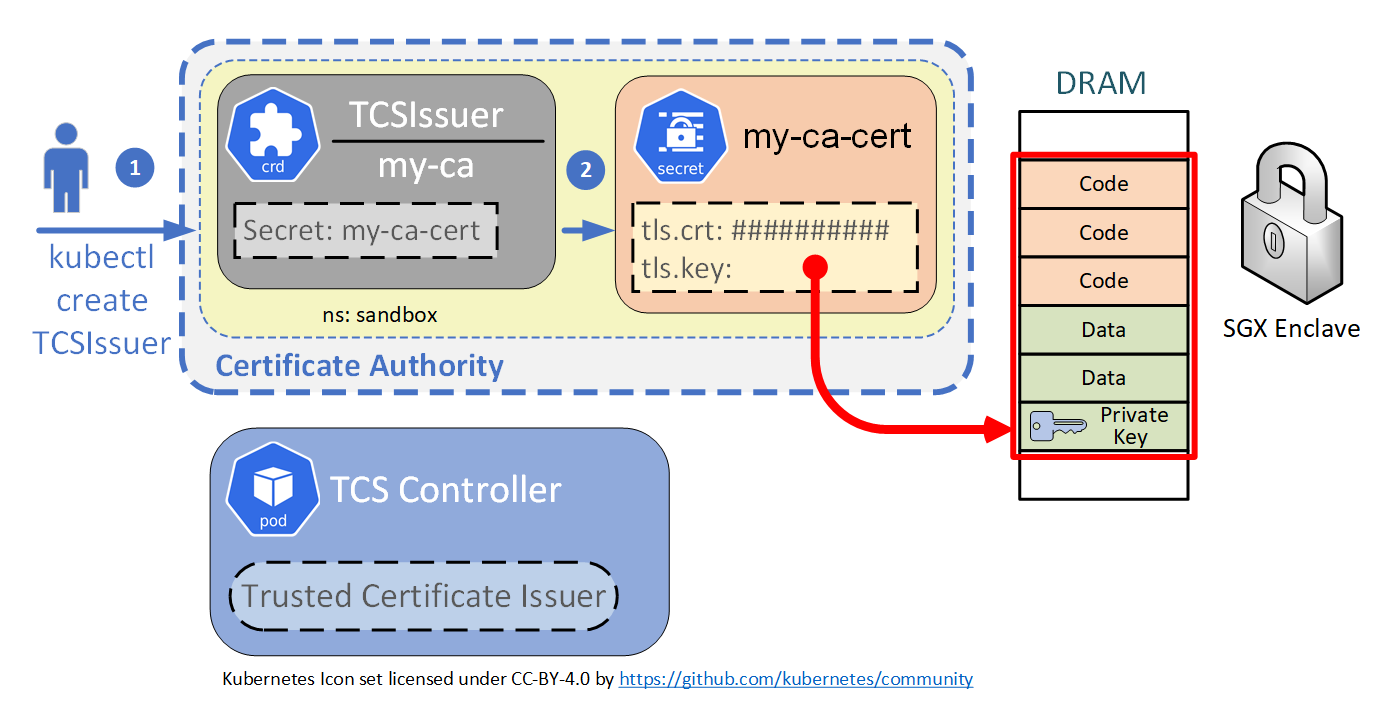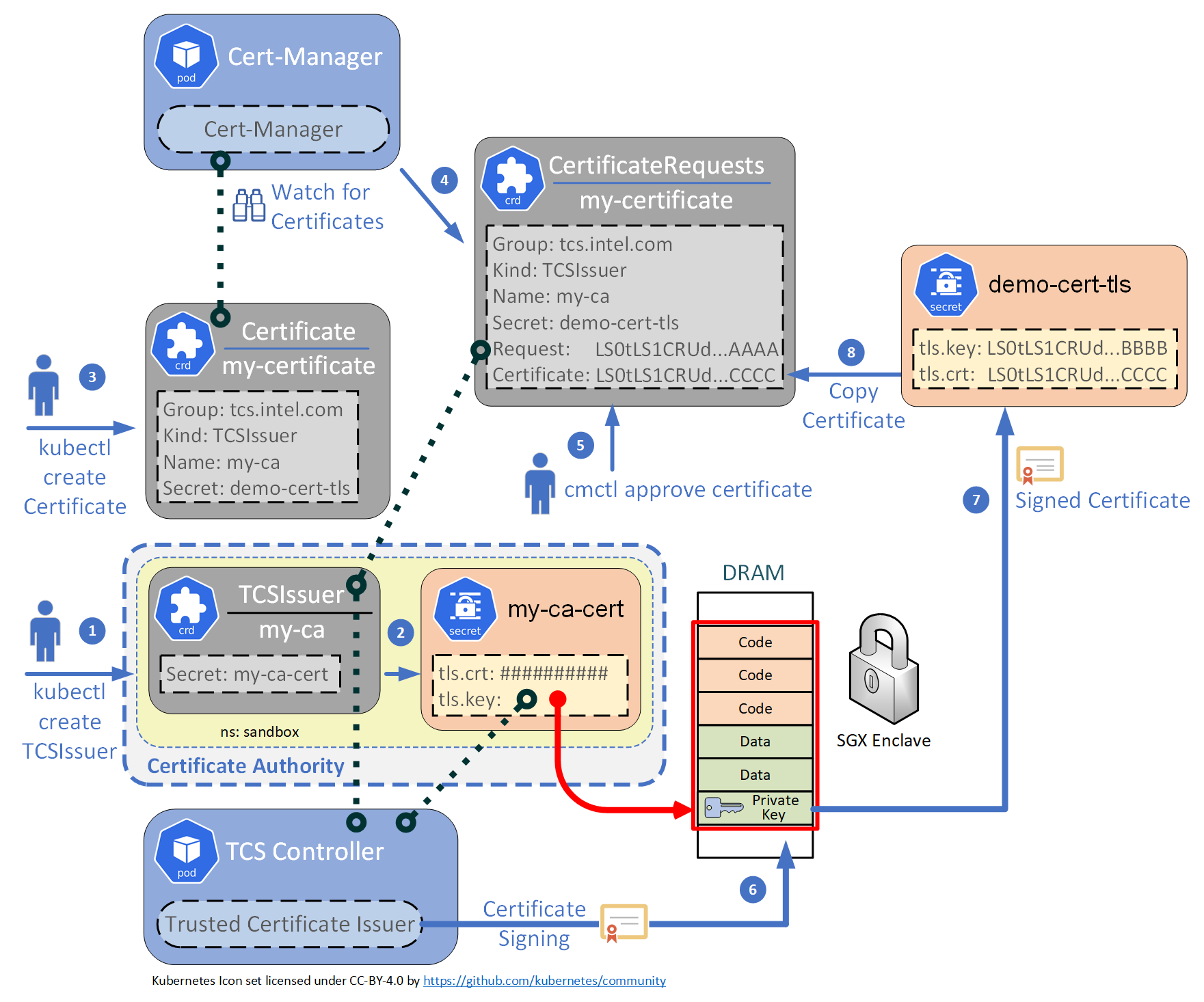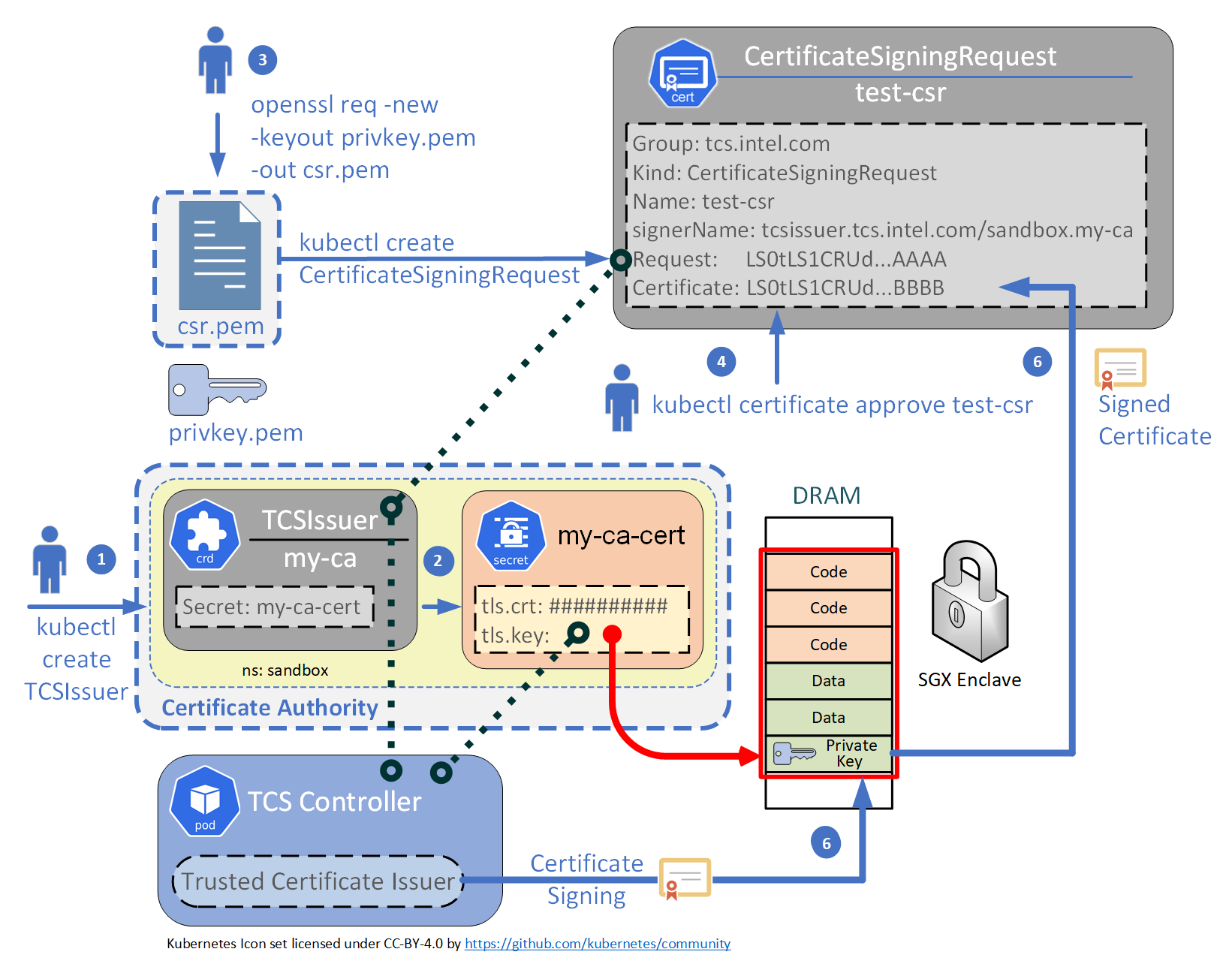Trusted Certificate Service (TCS) is a Kubernetes certificate signing solution that uses the security capabilities provided by Intel® Software Guard Extensions (Intel® SGX). The signing key is stored and used inside the Intel SGX enclave(s) and is never stored in clear anywhere in the system. TCS is implemented as a cert-manager external issuer by providing support for both cert-manager and kubernetes certificate signing APIs.
All the examples in this page are using self-signed CA certificates. If you are looking for more advanced use cases (e.g., Istio integration) please check the sample use cases.
Prerequisites for building and running Trusted Certificate Service:
- Kubernetes cluster with one or more nodes with Intel® SGX supported hardware
- Intel® SGX device plugin for Kubernetes
- Intel® SGX AESM daemon
- cert-manager. The
cmctlis also used later in the examples so you may want to install it also. - Linux kernel version 5.11 or later on the host (in tree Intel SGX driver)
- git, or similar tool, to obtain the source code
- Docker, or similar tool, to build container images
- Container registry (local or remote)
If you want to use Helm to install TCS see the document here.
This section covers how to obtain the source code, build and install it.
- Getting the source code
git clone https://github.com/intel/trusted-certificate-issuer.git- Build and push the container image
Choose a container registry to push the generated image using REGISTRY make variable.
The registry should be reachable from the Kubernetes cluster.
NOTE: By default, the enclave signing is done using a private key auto-generated by the TCS issuer. In case, if you want to integrate your own signing tool, modify/replace the
enclave-config/sign-enclave.shscript accordingly before building the docker image. Refer to Intel(R) SGX SDK developer reference for more details about enclave signing.
$ cd trusted-certificate-issuer
$ export REGISTRY="localhost:5000" # docker registry to push the container image
$ make docker-build
$ make docker-pushNOTE: If you operate behind a corporate proxy, proxy settings can be passed in like
make docker-build BUILD_ARGS="--build-arg http_proxy=someproxy --build-arg https_proxy=someproxy --build-arg no_proxy=some_list"
- Deploy custom resource definitions (CRDs)
# set the KUBECONFIG based on your configuration
export KUBECONFIG="$HOME/.kube/config"
make install # Install CRDs- Make the deployment
make deployBy default, tcs-issuer namespace is used for the deployment.
# Ensure that the pod is running state
$ kubectl get po -n tcs-issuer
NAME READY STATUS RESTARTS AGE
tcs-controller-5dd5c46b44-4nz9f 1/1 Running 0 30mOnce the deployment is up and running, you are ready to provision TCS
issuer(s) using either a namespace-scoped TCSIssuer or a
cluster-scoped TCSClusterIssuer resource.
The example below creates a TCS issuer named my-ca for sandbox namespace:
kubectl create ns sandbox
cat <<EOF |kubectl create -f -
apiVersion: tcs.intel.com/v1alpha1
kind: TCSIssuer
metadata:
name: my-ca
namespace: sandbox
spec:
secretName: my-ca-cert
EOFSuccessful deployment looks like this:
$ kubectl get tcsissuers -n sandbox
NAME AGE READY REASON MESSAGE
my-ca 2m True Reconcile Success
$ kubectl get secret my-ca-cert -n sandbox
NAME TYPE DATA AGE
my-ca-cert kubernetes.io/tls 2 3h14mThe above issuer creates and stores it's private key inside the Intel
SGX enclave and the root certificate is saved as a Kubernetes Secret with name
specified with spec.secretName, under the issuer's namespace.
Typically the issuer secret (my-ca-cert in our case) contains both the
certificate and the private key. But in the Trusted Certificate Service case, the
private key is empty since they key is stored and used inside a Intel SGX
enclave. You can verify the empty private key in the secret with the following
command:
kubectl get secrets -n sandbox my-ca-cert -o jsonpath='{.data.tls\.key}'Figure 1: Trusted Certificate Install
- The
TCSIssueris created. - This automatically creates the
my-ca-certsecret. Thetls.keyfield is blank because the private key is actually created and stored within a Intel SGX enclave.
Below is a demo of the install process.
Creating and signing certificates can be done by using cert-manager Certificate
or Kubernetes CertificateSigningRequest APIs.
This example shows how to request X509 certificate signed by the Trusted Certificate Service
using cert-manger Certificate API. Create a cert-manager Certificate object and
set the spec.issuerRef to TCSIssuer(or TCSClusterIssuer).
cat <<EOF |kubectl create -f -
apiVersion: cert-manager.io/v1
kind: Certificate
metadata:
name: my-certificate
namespace: sandbox
spec:
# The secret name to store the signed certificate
secretName: demo-cert-tls
# Common Name
commonName: intel.sgx.demo
# Ensure the issuerRef is set to the right issuer
issuerRef:
group: tcs.intel.com # TCS issuer API group
kind: TCSIssuer # Configured issuer type
name: my-ca # Configured issuer name
EOFThe cert-manager creates a corresponding CertificateRequest for the
Certificate above. One has to approve the CertificateRequest so that
the TCS controller can sign the request in the next reconcile loop.
$ kubectl get certificaterequest -n sandbox
NAME APPROVED DENIED READY ISSUER REQUESTOR AGE
my-certificate-nljcz False False my-ca system:serviceaccount:cert-manager:cert-manager 1mPrivileged user needs to approve the CertificateRequest with the cert-manager's cmctl utility:
$ cmctl approve my-certificate-nljcz -n sandboxCheck if the certificate is exported to the secret referenced in
the spec.secretName.
$ kubectl get certificates,secret -n sandbox
NAME READY SECRET AGE
certificate.cert-manager.io/my-certificate True demo-cert-tls 2m1s
NAME TYPE DATA AGE
secret/default-token-69dv6 kubernetes.io/service-account-token 3 3h15m
secret/demo-cert-tls kubernetes.io/tls 2 2m1s
secret/my-ca-cert kubernetes.io/tls 2 3h14mFigure 2: Trusted Certificate Issuer with cert-manager
- The
TCSIssueris created. - This automatically creates the
my-ca-certsecret. - A user creates a
Certificateobject specifying to use the TCS Issuer. - cert-manager automatically creates a
CertificateRequestsobject. - A user approves the
CertificateRequestsobject. - The TCS Controller then takes the request and signs the certificate inside the Intel SGX enclave using the private key stored within that enclave.
- The signed certificate is then copied into the
demo-cert-tlssecret that was specified in the originalCertificateobject. - Finally, that same signed certificate is copied back into the
CertificateRequestsobject.
Below is a demo of this working with cert-manager.
This example shows how to request an X509 certificate signed by the Trusted Certificate Service using Kubernetes CSR.
First, generate a PEM encoded private key (privkey.pem) and certificate signing request (csr.pem)
using openssl tool:
$ openssl req -new -nodes -newkey rsa:3072 -keyout privkey.pem -out ./csr.pem -subj "/O=Foo Company/CN=foo.bar.com"Create a Kubernetes CertificateSigningRequest using the csr (csr.pem) generated above.
The spec.signerName field must refer to the TCS issuer we configured earlier
in the form of <issuer-type>.<issuer-group>/<issuer-namespace>.<issuer-name>.
In this example the signer name is tcsissuer.tcs.intel.com/sandbox.my-ca.
Note: the issuer namespace in the case of tcsclusterissuer is the namespace
of the Trusted Certificate Service.
cat <<EOF |kubectl apply -f -
apiVersion: certificates.k8s.io/v1
kind: CertificateSigningRequest
metadata:
name: test-csr
spec:
groups:
- system:authenticated
request: $(cat csr.pem | base64 | tr -d '\n')
signerName: tcsissuer.tcs.intel.com/sandbox.my-ca
usages:
- client auth
EOFNow the test-csr is the in pending state waiting for approval.
$ kubectl get certificatesigningrequests
NAME AGE SIGNERNAME REQUESTOR CONDITION
test-csr 46s tcsissuer.tcs.intel.com/sandbox.my-ca kubernetes-admin PendingPrivileged user needs to approve the test-csr with the following command:
# Approve the CSR so the TCS controller generates the certificate
kubectl certificate approve test-csrOnce the request is approved, the Trusted Certificate Service signs it. At this point the CSR contains the requested certificate signed by the CA using the private key stored inside the Intel SGX enclave.
You can examine the CSR with the following command:
$ kubectl describe csr
Name: test-csr
Labels: <none>
Annotations: kubectl.kubernetes.io/last-applied-configuration={"apiVersion":"certificates.k8s.io/v1","kind":"CertificateSigningRequest","metadata":{"annotations":{},"name":"test-csr"},"spec":{"groups":["system:authenticated"],"request":"LS0tLS1CRUdJTiBDRVJUSUZJQ0FURSBSRVFVRVNULS0tLS0KTUlJRGNUQ0NBZGtDQVFBd0xERVVNQklHQTFVRUNnd0xSbTl2SUVOdmJXRndibmt4RkRBU0JnTlZCQU1NQzJadgpieTVpWVhJdVkyOXRNSUlCb2pBTkJna3Foa2lHOXcwQkFRRUZBQU9DQVk4QU1JSUJpZ0tDQVlFQTZhNzkvTmZLCmdrYzQ5dXd6TVFUajBwZzhuZjZ3VU5tcmNVaG5IUDNhUitDYjZKcE0wOVF3RHBmblI2VU13ejZFVy9RSis3WVQKMndLUFJTRVZqZ3owT29NdXh0c0tScGN2VCtWaDZkb3JjSkU0ZTdjQ2FWK1ZKN0pQRGtwYzdFNSt6VCtncVlRKwptMWhjS0FmTEk0VEpZNzJZR2MzTWt5QkVqRzNsKzl3emxHNVlpZEduYVFjNDhMNUJQSXFxOEdKelpWSTkvQWxLClVDVjcwM2pGQnpKdTBEbFpTQWd2WEo1RUhNbWVhaFBQYTFOV2dkM29mQ2FUcTlnM0xaSTBDejdWbndOK0l1bzEKNGpRcE1zNzVQTFZVUTQ2SEZ0YUxJTWZPNDlkZk94SUwwNlkwZG1XNUc0R05zNUR4SkhtYm11QlQ1NGMrUm5MUQoyVldJL2VRS2xQQW5Sdk00SmpEM3hEcENvOGViSE9nS2RsRU9MTkFPTEk0L2VMUG1GcXlTUGxuY2RTZlFqc2UvCkJQOEpuQk9Xa0xpSUZ4bzBwT1lrTUFDaHhWdDJkdURLcldRZm1JSkhUUSs0Q05OZjhlanZOZkZCY0pmNllldHUKRnlkNnA4WmwrYkV2TldYbDBKeGNQNWlFVGFYWkZqblJqMWxzZWVSbWo3OGFyRDZCUkhTTFlsM0pBZ01CQUFHZwpBREFOQmdrcWhraUc5dzBCQVFzRkFBT0NBWUVBMXYrOURlUE5XOER6Z2twVzBhU1czdW1xR05xc05zaWNhQjc1Cjc3UGsyRnNBMTMya2JWTXBBY2NCRzc1WGh4T0VkNFNYdTJ0eVI1MGxOMUpaNnJldzY5b1dUYWZTTTVXNm00RFAKcE1tVjRJbTJiajlUTUhYeHdXVjdXVk5JL2dQK1BFRDVROVJMNy82Sjh2VnV5aFhZaTAyc2NkampKaStIT0M4Ywo1TFpLem5TQUhtcmZEVGlveG5ydUNqY1ZEZlFlSGlJMkw1SW94aXAwUmt5L0Y1UkhwTjRyMHFQS25Na2F3enRYClV3alB6Nk9uWGVPK1EvVGZyRm5ka2V3OCtsSFc2akxneXNUNlU3SjdmdjVuL1lSUXdYSHJadi9LNFVneW9zU3oKZy9PSkZoOVpyWjl6WFBhT01sN1pLYnlUUXE2NGtMSmFEQys0eWIycXlUT1hMUm1xK0Y1MWc2a0tJdDdMWXdtMQpjR0N3WTc2WmFHMm9hVkQxRVNQSWtpc0I4U01ncVNEajlhQjFxRDJ0Y1E4RGxoV1o3dEdDd3M5VC9RUDlvQnpsCjc5S0g3Qnc1QnVSVFlRT0srMTdJSWUrNUx0YVFzS1dpczBsaGtvQ1R3TjdUS2FnQ1dLWWk0RE16em1wVlNvbTEKaVphb21nUDJIKy8yQ3RoOUNJN1dwVWR5WklkQgotLS0tLUVORCBDRVJUSUZJQ0FURSBSRVFVRVNULS0tLS0K","signerName":"tcsissuer.tcs.intel.com/sandbox.my-ca","usages":["client auth"]}}
CreationTimestamp: Mon, 24 Jan 2022 16:11:10 +0200
Requesting User: kubernetes-admin
Signer: tcsissuer.tcs.intel.com/sandbox.my-ca
Status: Approved,Issued
Subject:
Common Name: foo.bar.com
Serial Number:
Organization: Foo CompanyFigure 3: Trusted Certificate Issuer with Kubernetes CSR
- The
TCSIssueris created. - This automatically creates the
my-ca-certsecret. - A user creates a certificate signing request using openssl and saving the
private key. Using that
csr.pemfile, aCertificateSigningRequestobject is created in Kubernetes. - A user approves the
CertificateSigningRequestobject. - The TCS Controller then takes the request and signs the certificate inside the Intel SGX enclave using the private key stored within that enclave.
- The signed certificate is then copied back into the original
CertificateSigningRequestobject into thecertificatefield.
Below is a demo of this working with Kubernetes CSR.
You can deploy TCS also in Azure by following the instructions here.
Refer to more example use cases related to Istio service mesh and Trusted Certificate Service
- Istio custom CA integration using Kubernetes CSR
- Istio integration with cert-manager and istio-csr
- Remote attestation and key management (manual)
- This version of the software is pre-production release and is meant for evaluation and trial purposes only.
- The certificate authority (CA) private key transport method (via QuoteAttestation custom resource) does not guarantee any authenticity, only confidentiality, and therefore cannot protect from attacks like key substitution or key replay.


